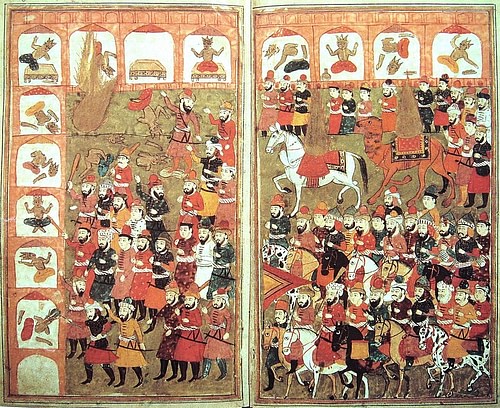The Giza Pyramid Complex is one of the most famous and iconic landmarks in Egypt, and it has a rich history that spans thousands of years. Here is an overview of the history of the Giza Pyramid Complex:
 |
| The Old Kingdom Period (2686-2181 BC) |
The Old Kingdom Period (2686-2181 BC): The Giza Pyramid Complex was built during the Old Kingdom period of ancient Egypt. It is believed that the complex was commissioned by the pharaoh Khufu (also known as Cheops) and was completed around 2560 BC. The complex originally included three large pyramids, which were built for Khufu, his son Khafre, and his grandson Menkaure.
 |
| The Middle Kingdom Period (2055-1650 BC) |
The Middle Kingdom Period (2055-1650 BC): During the Middle Kingdom period, the Giza Pyramid Complex fell into disrepair, and many of the buildings and monuments were damaged or destroyed.
 |
| The New Kingdom Period (1550-1070 BC) |
The New Kingdom Period (1550-1070 BC): During the New Kingdom period, the Giza Pyramid Complex was partially restored and renovated by several pharaohs, including Amenhotep II and Ramesses II. Some of the damaged structures were repaired, and new structures were added to the complex.
| The Late Period (664-332 BC) |
The Late Period (664-332 BC): During the Late Period, the Giza Pyramid Complex was used as a necropolis for the burial of high-ranking officials and members of the royal family. Many tombs and smaller pyramids were constructed in the area surrounding the main pyramids.
 |
| The Ptolemaic and Roman Periods (332 BC-395 AD) |
The Ptolemaic and Roman Periods (332 BC-395 AD): During the Ptolemaic and Roman periods, the Giza Pyramid Complex continued to be used as a burial site. Some of the tombs and monuments in the complex were renovated, and new tombs were added.
 |
| The Islamic Period (7th century AD-present) |
The Islamic Period (7th century AD-present): During the Islamic period, the Giza Pyramid Complex was used as a quarry for building materials, and many of the outer casing stones of the pyramids were removed. However, the complex remained an important landmark, and it was visited by many travelers and explorers.
Today, the Giza Pyramid Complex is a popular tourist attraction and a UNESCO World Heritage Site. It is one of the most recognizable landmarks in the world and remains an important symbol of ancient Egyptian civilization.
- The construction of the Giza Pyramids took place during the 4th dynasty of the Old Kingdom Period, which lasted from 2613 BC to 2494 BC.
- The complex consists of three main pyramids: the Great Pyramid of Khufu, the Pyramid of Khafre, and the Pyramid of Menkaure. The Great Pyramid of Khufu is the largest of the three and is one of the Seven Wonders of the Ancient World.
- It is estimated that the construction of the Great Pyramid took around 20 years and required the labor of around 100,000 workers. The exact methods used to construct the pyramids are still a subject of debate among historians and archaeologists.
- The Giza Pyramid Complex was not just a burial site, but also included temples, causeways, and smaller pyramids for the pharaoh's family members and officials.
- The Sphinx, a large statue of a mythical creature with the head of a human and the body of a lion, is also located at the Giza Pyramid Complex. The Sphinx is believed to have been built during the reign of Khafre and is the largest monolithic statue in the world.
- Over the centuries, the Giza Pyramid Complex has been subject to looting, vandalism, and natural disasters. Many of the outer casing stones were removed and used in the construction of other buildings, leaving the pyramids with their distinctive stepped appearance.
- The pyramids were built as tombs for the pharaohs and their consorts. It was believed that the pharaohs would be able to continue their rule in the afterlife and enjoy the same status and luxuries that they had in life.
- The Giza Pyramid Complex was not only a place of worship and burial, but also an important center for religious rituals and ceremonies. The complex housed priests and other religious officials who were responsible for performing these ceremonies.
- The Giza Pyramid Complex was also an important economic center, as the production of food and other goods was needed to support the workers who built and maintained the pyramids. This production was organized by the central government and included the collection of taxes and the distribution of food and other resources.
- The Giza Pyramid Complex was part of a larger complex of pyramids and temples that extended along the Nile River. Other notable pyramids in the area include the Step Pyramid of Djoser at Saqqara and the Bent Pyramid and Red Pyramid at Dahshur.
- The Giza Pyramid Complex was rediscovered by European explorers in the 18th and 19th centuries, and has since become one of the most famous and iconic landmarks in the world. The pyramids have been the subject of many works of art, literature, and film, and continue to capture the imagination of people around the globe.




0 Comments